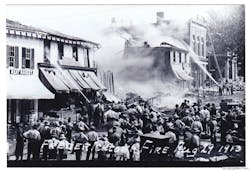BANGOR, ME: AUG. 1, 1913 – A nighttime fire that started in the business district in the manufacturing plant of the S. Flory Co. destroyed the entire structure and spread to several other buildings, including a house. Firemen saved a small building and the mill and grain elevator of the company.
LINDENHURST, NY: AUG. 2, 1913 – The temporary pastor of Our Lady of Perpetual Help Roman Catholic Church, the Reverend C.B. Lutz, his 67 year-old mother and the rectory housekeeper battled a fire that started late at night. Just before retiring for the night, the housekeeper saw fire in the church and cried for help. The priest dashed to the church, dragging a garden hose behind him, and battled the flames with the small stream as the women dashed back and forth rescuing valuable church items. Their quick action held the flames to a small room until volunteer firemen arrived and doused the last of the flames.
PEN MAR, MD: AUG. 5, 1913 – A blaze broke out at 5 A.M. in the kitchen of the Blue Mountain House, a hotel on the Maryland-Pennsylvania border. A porter working in the hotel roused the sleeping guests, who fled the smoke-filled wooden building in their nightclothes. Several guests were unable to escape and were lost in the flames. One hundred and seventy-five people were saved, but two perished.
PITTSBURGH, PA: AUG. 9, 1913 – The old Westinghouse Electric and Manufacturing Co. factory at French Street and Garrison Alley was destroyed by an early-morning fire. Three firemen were injured battling the two-alarm blaze in one of the city’s best-known landmarks, the building where many of George Westinghouse’s inventions came to life. At the time of the fire, the buildings were occupied by the Nernst Lamp Co., Smith Publishing Co. and Pittsburgh Electrical Specialties Co. The six-story factory became a wall of flames requiring the entire downtown force of the fire department to contain.
NEW YORK CITY: AUG. 13, 1913 – A costly fire in a factory in the Devoe oil yards at the foot of Ninth Street along the East River in Long Island City also cost the life of an FDNY fireman and injured several others. With the fire threatening to extend to the many flammables stored nearby, the fireboat Abram S. Hewitt moved to battle the flames. As the bow gun was operating and delivering a stream of water at more that 130 pounds of pressure, it suddenly tore loose from the boat’s deck and flew into the air. The nozzle and base, weighing close to a half-ton, blasted upward and struck the operator, Fireman Brereton E. Johnson of Engine 77 (later listed as Boat 7 and Marine 7 in archives), in the head as it rocketed by. He was killed instantly. An officer responding to the blaze with Engine 202 was thrown from the rig and fractured his skull on the pavement. A 14-year-old boy watching the fire fell into the water and was injured by flying debris. He too was taken to the hospital. As firemen were taking up from this job, they raced 10 blocks to a blaze in the very hospital the injured had been taken to hours before. Happily, this fire proved to be of little consequence.
NORTH ANSON, ME: AUG. 19, 1913 – Every place of business in town and seven homes were destroyed by flames after a lamp exploded in the Hotel Somerset. In all, about 30 buildings burned to the ground, but there were no injuries.
JERSEY CITY, NJ: AUG. 20, 1913 – The worst fire in the city’s history started at 12:20 P.M. in the storeroom above the office of the cooperage plant of Charles Heidt & Sons at 42 Fairmount Ave. The barrel factory occupied the entire block and the workers were all at lunch when the fire broke out. With a half-hour head start, the flames raced through the huge building and were way beyond control before the fire was noticed. Two simultaneous box alarms sent half the force to the wrong location, letting the fire spread even more. Engine 10 arrived first and was placed in front of the fire building as the attack began. Suddenly, the wind changed direction and drove sheets of fire across the street, igniting the pumper and sending firemen running for their lives. The flames that ignited the engine also set fire to the entire row of 15 tenements across the street. With the entire neighborhood now threatened, a general alarm was transmitted to bring the entire department to the scene. Despite the heroic efforts of firemen, four city blocks, including six factories, 30 tenements and a lumberyard, were consumed by the flames. About 1,000 people were left homeless and more than a dozen were injured.
PAUL HASHAGEN, a Firehouse® contributing editor, is a retired FDNY firefighter who was assigned to Rescue 1 in Manhattan. He is also an ex-chief of the Freeport, NY, Fire Department. Hashagen is the author of FDNY: The Bravest, An Illustrated History 1865-2002, the official history of the New York City Fire Department, and other fire service books. His latest novel, Fire of God, is available at dmcfirebooks.com.
About the Author
Paul Hashagen
PAUL HASHAGEN, a Firehouse® contributing editor, is a retired FDNY firefighter who was assigned to Rescue 1 in Manhattan. He is also an ex-chief of the Freeport, NY, Fire Department. Hashagen is the author of FDNY: The Bravest, An Illustrated History 1865-2002, the official history of the New York City Fire Department, and other fire service books.
Connect with Paul
Website: paulhashagen.com
Facebook: Paul Hashagen-author
